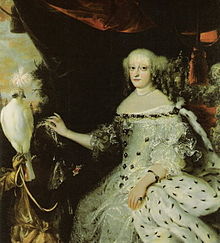This article needs additional citations for verification. (March 2018) |
Kammermohr (or Hofmohr; pl. Kammermohren, lit. "chamber-black") was a German-language term since the 18th century for a court servant of black skin colour, which had by that time long been a common feature in European courts.[1]


History
editPeople of black skin colour from the Orient, Africa and America had often been taken to Europe as valets during the time of colonialism. This became common in the 16th-century and continued to be fashionable until the early 19th-century. The term Kammermohr was first used as an official term in a court protocol in 1747 in Saxon.
The splendidly decorated Kammermohr, often in livery, served a ruler, church dignitaries or wealthy merchants as an exotic object of prestige and as a status symbol, showcasing their wealth and luxury lifestyle. Above all, however, the valets symbolized the worldwide relations of their employer.
Etymology
edit'Kammer' is the German word for chamber, in particular the private rooms of a wealthy person. 'Mohr' is ultimately derived from the name for the Moors, a historic people in the western Mediterranean who originated from northern Africa during the Middle Ages.
Hence, 'Kammermohr' would translate to 'chamber Moor'.
Other similarly derived words include Blackamoor, Matamoros, Maure, Mohr im Hemd, Moresca, Moresche, Moresque, Moreška, Morianbron, Morisco, Moros y cristianos, and Morris dance.
Notable examples
edit- Anton Wilhelm Amo, kammermohr of Anthony Ulrich, Duke of Brunswick-Wolfenbüttel.
- Adriaan de Bruin, kammermohr
- Angelo Soliman, kammermohr of Austrian Emperor Joseph II.
- Ignatius Fortuna, kammermohr of Countess Palatine Francisca Christina of Sulzbach
- Gustav Badin, kammermohr of first Queen Louisa Ulrika of Sweden and then Princess Sophia Albertine of Sweden.
- Abraham Petrovich Hannibal, kammermohr of Peter the Great
See also
editReferences
edit- ^ Atlantic understandings: essays on European and American history in honor of Hermann Wellenreuther (in German). LIT Verlag. 2007. p. 88. ISBN 978-3825896072.